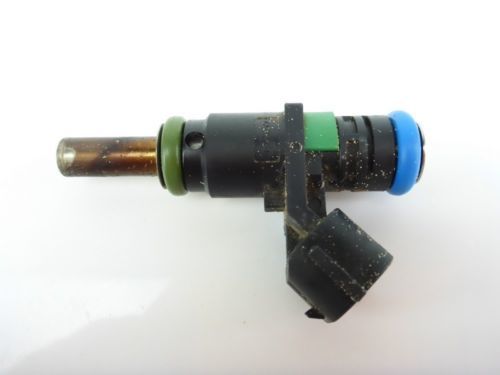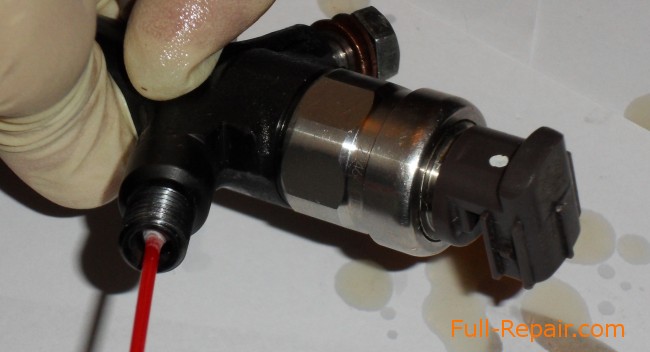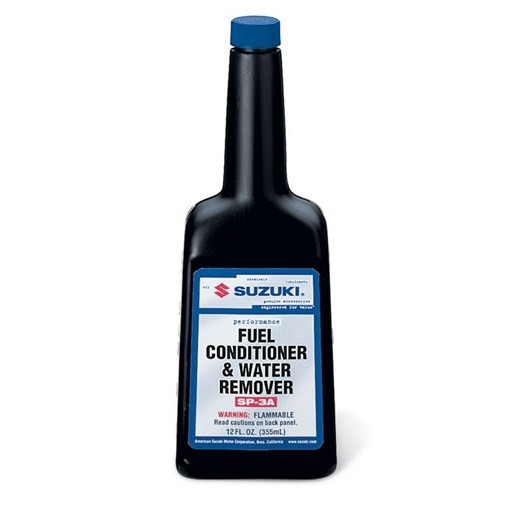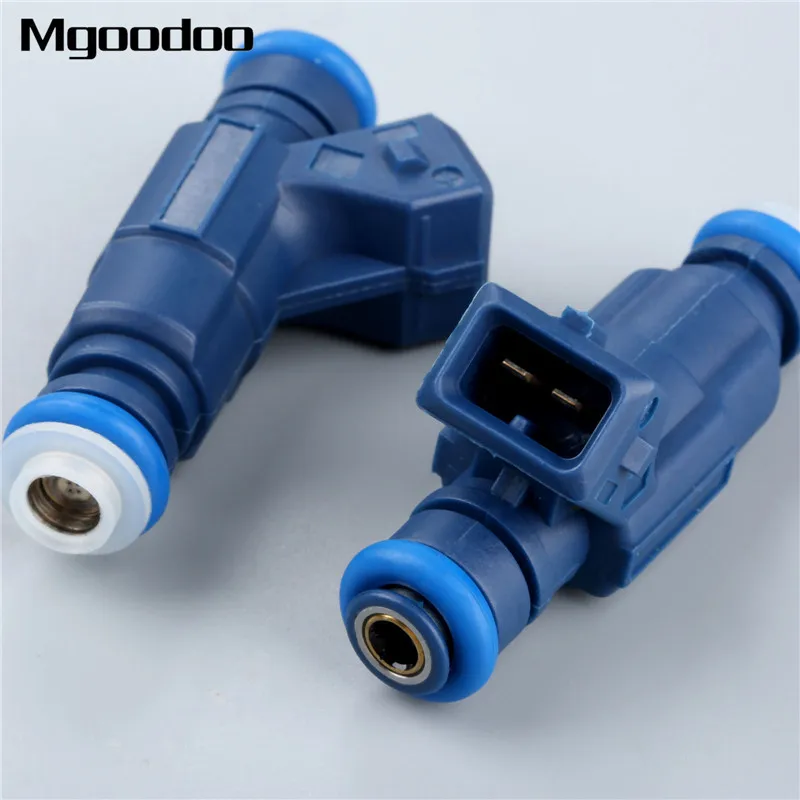Delivery options and delivery speeds may vary for different locations
Sign In
or enter a zip code
Email * Password *
REPAIR & HOW TO
MAINTENANCE
TROUBLESHOOTING
GUIDES
TIPS & TRICKS
ALL ARTICLES WATCH VIDEOS ABOUT US SHOP PARTS CONTACT US
When was the last time you cleaned your vehicle's fuel injectors? Sure, we all change out the oil and air filters regularly enough, but the fuel injectors often get overlooked.
The fuel injectors are essential for delivering the correct fuel-to-air ratio to the engine, which ensures a clean burn and maximum power from your motor. Over time, the ethanol found in modern fuels creates varnish-like deposits within the spray tips of the fuel injectors. Tiny specs of dirt or other contaminants will also affect the spray tips' effectiveness, and thus the all-important fuel-to-air ratio.
Typical symptoms of fouled or dirty fuel injectors include: loss of top-end power, unexpected power surges under throttle, poor idling, and increased fuel consumption. Watch the video above and follow the steps below to learn how to clean fuel injectors.
Tools and Parts - Fuel Injector CleaningNOTE: We used a Motion Pro HV2 fuel injector cleaning kit for this task. This tool cleans most types of fuel injectors, and Motion Pro offers different pigtail adapters to fit various injector styles, so you can use the cleaner kit on your sport bike, dirt bike, ATV or side-by-side.
Preparing Fuel InjectorsStep 1. Remove the fuel injector(s) from your vehicle. Consult the service manual for the manufacturer's instructions on how to remove the injectors(s) from your vehicle's make and model.
Consult the service manual for the manufacturer's instructions on how to remove the injectors(s) from your vehicle's make and model.
Step 2. Test that the fuel injector cleaner tool is working by pressing the red button. If the red light doesn't illuminate, remove the plate from the cleaner tool and install a new 9-volt battery.
Step 3. Clean the outside of the fuel injector with brake/contact cleaner. You want the fuel injector to be as clean as possible, so there's no risk of dirt or contaminants getting into it.
Flushing Fuel InjectorsStep 1. Remove the two screws holding the retaining clamp onto the cleaner tool.
Step 2. Place the engine side of the fuel injector into PORT 2 of the cleaner tool, with the fuel injector's electrical connector facing outward from the cleaner tool.
NOTE: Most fuel injectors will fit into PORT 2. However, some types of injector may have to use PORT 1 in this step.
However, some types of injector may have to use PORT 1 in this step.
Step 3. Reinstall the clamp and two screws, and carefully tighten down the clamp so it lightly compresses the fuel injector's lower seal against the cleaner tool.
NOTE: Don't overtighten the clamp, and be careful not to damage the fuel injector and its O-rings.
Step 4. Connect the adapter end of the pigtail adapter to the fuel injector, and plug the electrical connector end of the pigtail into the cleaner tool.
Step 5. Press the red button on the cleaner tool and listen for the click, which is the solenoid within the fuel injector opening and allows cleaner fluid to pass through it.
Step 6. Loosen the red knob on the cleaner tool opposite the port that the fuel injector is housed in. In most cases, it's PORT 2.
Step 7. Insert the tube from a can of contact cleaner fluid into the red knob, and gently re-tighten the knob to seal the tube within the cleaner tool.
Step 8. Press and hold the red button on the cleaner tool to activate the fuel injector, and spray the cleaner fluid into the fuel injector for a few seconds to flush it out. Repeat this step a couple of times.
NOTE: Because the cleaner fluid is passing through the fuel injector in the opposite direction to regular fuel flow, there will not be a spray pattern coming from the injector at this point.
Step 9. Remove the pigtail from the fuel injector and cleaner tool, then loosen the clamp and remove the injector from the tool.
Cleaning Fuel InjectorsStep 1. Remove the fuel injector's lower seal so it won't get damaged. Place the fuel side of the fuel injector into PORT 1 of the cleaner tool, with the fuel injector's electrical connector facing outward from the cleaner tool.
NOTE: It may be necessary to remove the O-ring from the fuel side of the fuel injector to allow the injector to seat into the cleaner tool. Most fuel injectors will fit into PORT 1, however some types of injector may have to use PORT 2 in this step.
Most fuel injectors will fit into PORT 1, however some types of injector may have to use PORT 2 in this step.
Step 3. Reinstall the clamp and two screws, and carefully tighten down the clamp.
NOTE: Once again, don't overtighten the clamp, and be careful not to damage the injector.
Step 4. Reconnect the adapter end of the pigtail to the fuel injector, and plug the electrical connector end of the pigtail into the cleaner tool. Press the red button on the cleaner tool and listen for the click from the fuel injector's solenoid.
Step 5. Loosen the red knob on the cleaner tool opposite the port that the fuel injector is housed in (in most cases PORT 1), then insert the tube from the fuel contact cleaner fluid into the red knob and gently re-tighten the knob.
Step 6. Press and hold the red button on the cleaner tool, and spray the cleaner fluid into the fuel injector for a few seconds to clean it. Repeat this step a couple of times.
Repeat this step a couple of times.
NOTE: The cleaner fluid is now passing through the fuel injector in the normal direction of fuel flow, and there should be a good spray pattern coming from the injector. Look for a consistent, even spray pattern. If the spray pattern isn't consistent, you'll need to go back and repeat the flushing process, and then run through the cleaning process once more.
Step 7. Remove the pigtail from the fuel injector and cleaner tool, then loosen the clamp and remove the injector from the tool. Reinstall the fuel injector's lower seal, and also reinstall the O-ring if you removed in Step 1.
Step 8. Reinstall the fuel injector(s) back into your vehicle and you're done.
body
Clogged Fuel Injectors
Clogged fuel injectors, unlike dirty injectors which reduce fuel flow, prevent fuel from flowing through them.
Diagnosing dead or clogged fuel injectors is difficult because it acts the same than a bad coil, dead spark plug, broken spark plug wires and or electrical problem.

Moving the suspect injector to another cylinder is one way of diagnosing the problem. If the problem moves with the injector then Bingo. Unfortunately on some engines this can take hours to do.
If the problem moves with the injector then Bingo. Unfortunately on some engines this can take hours to do.
If a vehicle, watercraft, motorcycle or pleasure craft sat for an extended period with gasoline in the tank, it can be assumed that the fuel system is gummed up with bad fuel, varnish and sediment. In a situation like this the entire fuel system has to be cleaned.
Fuel injectors become clogged due to hydrocarbons, sediment and other elements in the fuel. Most fuels contain ethanol. Ethanol is hygroscopic thus drawing moisture from the air into the fuel. The water in the fuel cause internal components to rust. Residue from the rust gets into the injectors when the fuel filter is in bad shape.
Some smaller and older service stations has debris and sediment in their storage tanks and that sediment and debris which eventually can make its way to the injectors is pumped into the fuel tank. Injectors also get gummed up with varnish and gunk which formed when fuel is left in the tank for long periods of time.
Injectors also get gummed up with varnish and gunk which formed when fuel is left in the tank for long periods of time.
Although there are many products such as injection cleaning additives that claim it can clean or unclog a clogged fuel injector while it is in the engine, they cannot. For any of these products to work they actually have to get inside the injector. Common sense predicts that if you cannot get inside something, you are not going to be able to clean it.
By adding fuel injector cleaners to the fuel, the problem will most probably be exacerbated. Why? The injector cleaner has a cleaning affect on everything it touches. All the debris loosened by the cleaner is pumped to the fuel injector set that already has a problem. This makes the problem worse because more debris is pushed into the injectors or the pathway to the injectors. To unclog a clogged fuel injector properly the filter basket must be removed. Sediment and dirt built up between the pintle shaft and injector body must be cleaned. Once it is verified that the injector is completely clean, new filter baskets can now be installed.
Sediment and dirt built up between the pintle shaft and injector body must be cleaned. Once it is verified that the injector is completely clean, new filter baskets can now be installed.
The only guaranteed way to unclog a clogged injector properly is by removing the injectors from the engine. Once removed, the injectors can be dropped off or mailed to a professional injector cleaning service such as Injector RX. Injector RX uses manufacturer approved equipment and an ultrasonic fuel injector cleaning process to clean fuel injectors. Once cleaned the fuel injectors are flow tested to confirm that they spray correctly and deliver the right amount of fuel. The advantages of this method allows Injector RX to fully clean each injector, replace worn parts with new ones and test each injector for fuel flow comparison.
Let us help you save money and time. Before you decide what to do we strongly suggest you first read this article on the various fuel injector cleaning methods.
A dead fuel injector is an injector that does not have resistance and does not respond to electrical input.They act the same than a clogged injector.
Dead fuel injectors cannot be repaired and should be replaced with the exact same unit.
Go to Top
Why do I need to flush the injector?
Engines of modern cars are very sensitive to the quality of fuel, which, unfortunately, in our country still leaves much to be desired. It is with the quality of the fuel that frequent calls to the service of motorists with fuel system problems are associated. Consider why this happens - when the engine is running, even on high-quality fuel, the injection system is gradually contaminated, this is due to the presence of heavy fractions in the composition of gasoline.
Products for cleaning the power system Injection Reiniger Effectiv, injection Reiniger High Performance, Direkt Injection Reiniger, Langzeit Injection Reiniger and Injection Clean Light are produced and packaged only in Germany!
Dirty and cleaned injectors
Dirty occurs on any fuel!
The usual complaints of car owners after using low-quality fuel are: “bad start”, “car does not pull”, “increased consumption”. Low-grade fuel contaminates the fuel supply system to the combustion chamber much faster. This is due to the fact that such fuel, when burned, leaves behind a lot of deposits containing resins and carbon on the heated parts of the fuel equipment. These products of oxidation and incomplete combustion contaminate the injectors and valves, make it difficult to properly dose fuel and normal air circulation, so flushing is required, for which a special cleaner must be used.
Low-grade fuel contaminates the fuel supply system to the combustion chamber much faster. This is due to the fact that such fuel, when burned, leaves behind a lot of deposits containing resins and carbon on the heated parts of the fuel equipment. These products of oxidation and incomplete combustion contaminate the injectors and valves, make it difficult to properly dose fuel and normal air circulation, so flushing is required, for which a special cleaner must be used.
After the engine is stopped, the pollution process is most intense - there is no cooling effect from the flow of gasoline on the injectors, but the heating of the body from the hot engine still continues. At this point, light fractions evaporate, and heavy fractions clog the nozzles, accumulating in the form of varnish and resinous deposits. Even a small deposit of 4-7 microns can reduce the throughput of a calibrated channel by 20-30%! Violating thereby the quality of fuel spray in the combustion chamber. Poor-quality fuel atomization entails incomplete combustion of the air-fuel mixture, engine thrust drops, consumption increases, and most importantly, the situation with the condition of the injectors is only getting worse.
Nozzle Spray Example
How do you know when it's time to clean your nozzles?
Timing mechanism
How can I clean the nozzles myself?
To help the car owner avoid costly repairs and wasted time waiting in line at the service station, Liqui Moly offers a wide range of special injector cleaning products.
Injector cleaning, can be done independently and quickly. It is enough to add Liqui Moly cleaner to the gas tank along with gasoline, this can also be done when refueling the car. After that, you can operate the car in the usual mode. During the cleaning process, the additive components will gently and safely dissolve the contaminants inside the nozzle and the operation of the fuel equipment will be fully restored. The components of the additive are absolutely safe and begin to work only at the operating temperature of the engine, so they do not affect the contents of the gas tank, do not raise dirt. After the procedure for cleaning the fuel system of the car, fuel consumption decreases, power characteristics are restored, the engine starts without problems. A timely cleaning procedure allows the car owner to significantly save money and time.
The components of the additive are absolutely safe and begin to work only at the operating temperature of the engine, so they do not affect the contents of the gas tank, do not raise dirt. After the procedure for cleaning the fuel system of the car, fuel consumption decreases, power characteristics are restored, the engine starts without problems. A timely cleaning procedure allows the car owner to significantly save money and time.
Long -term injector Langzeit Injection Reiniger
Soft purifier injector Inject Clean Light
Maxim Stroker
The formation of deposits on the details of injectors of gasoline engines is a natural process that begins as soon as the first fuel in a car's tank is poured into the car's tank, and the engine begins to wind the motor-hours of its work. But the rate of development of the process already depends on a number of conditions - the quality of the fuel, the operating modes of the internal combustion engine, its design features, etc. The worst conditions are the use of low-quality or expired fuel, short trips on a cold engine, prolonged operation of the internal combustion engine Idling. In general, urban modes of operation. Often after the winter, the owner of the car notices that, despite shorter warm-ups, fuel consumption not only did not decrease, but, on the contrary, increased. The car began to accelerate more sluggishly. At idle, the internal combustion engine runs unevenly.
But the rate of development of the process already depends on a number of conditions - the quality of the fuel, the operating modes of the internal combustion engine, its design features, etc. The worst conditions are the use of low-quality or expired fuel, short trips on a cold engine, prolonged operation of the internal combustion engine Idling. In general, urban modes of operation. Often after the winter, the owner of the car notices that, despite shorter warm-ups, fuel consumption not only did not decrease, but, on the contrary, increased. The car began to accelerate more sluggishly. At idle, the internal combustion engine runs unevenly.
If you put the nozzles on the stand and apply pressure, then the coked atomizers will give themselves out as a pitiful stream, while the clean ones will demonstrate a magnificent flame of atomized fuel. At the same time, resin-coated valves will “poison” and not cut off the fuel supply as required. What kind of qualitative mixing will be discussed in this case? Hence the excessive consumption of gasoline, a decrease in power and uneven operation of the engine, a drop in the dynamics of the car. The solution to these problems is cleaning the nozzles. For this, there are special ultrasonic stands on which the dismantled units are installed. Success depends on the experience of the master, the perfection of the equipment, the quality of the compositions used for cleaning. The more cylinders an internal combustion engine has, the more difficult it is to access the injectors, the more expensive the service will cost.
The solution to these problems is cleaning the nozzles. For this, there are special ultrasonic stands on which the dismantled units are installed. Success depends on the experience of the master, the perfection of the equipment, the quality of the compositions used for cleaning. The more cylinders an internal combustion engine has, the more difficult it is to access the injectors, the more expensive the service will cost.
As an alternative to an expensive service procedure, you can use special injector cleaning compounds that are poured into the fuel tank before refueling the car. The drug begins to work immediately, and the effect of its use will be felt and grow as the fuel is consumed. It is important to correctly choose such a cleaning composition. There are many of them and they have different properties. We will not consider cheap additives (for example, from Asia) that contain "hard" solvents. They have a “impact” effect on pollution, literally tearing them off in layers and raising all the dirt from the bottom of the tank, which leads to clogging of the fuel filter and blocking the channels in the nozzles.
Products manufactured and certified in Europe can be used. For example, Liqui Moly preparations, which are effective and safe for use in any nutrition systems. Instead of cheap, strong solvents, the company uses modern and expensive surface-active substances (surfactants), which work "softly" and do not lead to an avalanche-like washing off of contaminants with clogged filters and clogged nozzle channels. Surfactants do not lead to the destruction of rubber seals and corrosion of metals.
For cleaning injectors of direct injection systems GDI, FSI, D4, a special Direkt Injection Reiniger is intended, the use of which is similar in its effectiveness to cleaning on an ultrasonic stand.
417904
candles, in a word, all the elements on which the operation of the motor depends. Injection Clean Light is a "mild" prophylactic that should prevent problems from occurring. If the symptoms of contamination of the power system are on the face, then you need to use either the “average” Injection Reiniger Effectiv composition, or the most powerful Injection Reiniger High Performance.